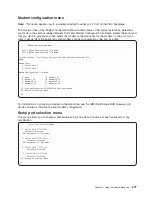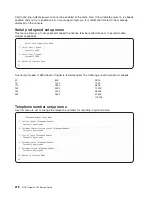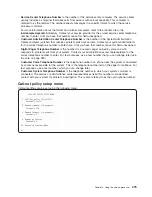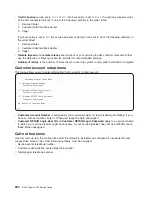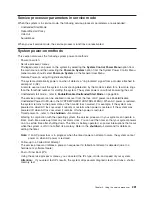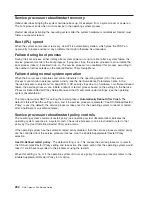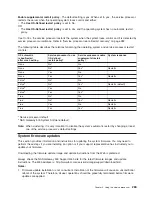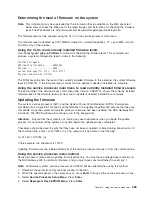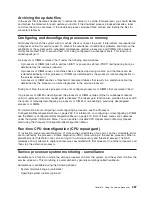
Service processor operational phases
This section provides a high-level flow of the phases of the service processor.
SP Power Applied
Pre-Standby Phase
Standby Phase SP Menus Available
Bring-Up Phase SMS Menus Available
Run-time Phase Operating System Login Prompt Available
Pre-standby phase
This phase is entered when the system is connected to a power source. The system may or may not be
fully powered on. This phase is exited when the power-on self-tests (POSTs) and configuration tasks are
completed.
The pre-standby phase components are:
v
Service Processor Initialization - Service processor performs any necessary hardware and software
initialization.
v
Service Processor POST - Service processor conducts Power-on self-tests on its various work and code
areas.
v
Service Processor Unattended Start Mode Checks - To assist fault recovery. If unattended start mode is
set, the service processor automatically reboots the system. The service processor does not wait for
user input or power-on command, but moves through the phase and into the bring-up phase. Access
the SMS menus or the service processor menus to reset the unattended start mode.
Standby phase
The standby phase can be reached in either of the following ways:
v
With the system off and power connected (the normal path), recognized by
OK
in the operator panel.
OR
v
With the system on after an operating system fault, recognized by an 8-digit code in the operator panel.
In the standby phase, the service processor takes care of some automatic duties and is available for
menus operation. The service processor remains in the standby phase until a power-on request is
detected.
The standby phase components are as follows:
v
Modem Configuration
The service processor configures the modem (if installed) so that incoming calls can be received, or
outgoing calls can be placed.
v
Dial In
Monitors incoming phone line to answer calls, prompts for a password, verifies the password, and
remotely displays the standby menu.
v
Menus
The service processor menus are password-protected. If the passwords have been set before you can
access them, you need either the general user-password or privileged-user password.
Chapter 9. Using the service processor
291
Summary of Contents for TotalStorage NAS Gateway 500
Page 1: ...IBM TotalStorage NAS Gateway 500 Service Guide GY27 0418 00 ...
Page 2: ......
Page 3: ...IBM TotalStorage NAS Gateway 500 Service Guide GY27 0418 00 ...
Page 16: ...xiv NAS Gateway 500 Service Guide ...
Page 20: ...xviii NAS Gateway 500 Service Guide ...
Page 36: ...System logic flow Note Not all components are supported 16 NAS Gateway 500 Service Guide ...
Page 52: ...32 NAS Gateway 500 Service Guide ...
Page 58: ...38 NAS Gateway 500 Service Guide ...
Page 112: ...92 NAS Gateway 500 Service Guide ...
Page 266: ...246 NAS Gateway 500 Service Guide ...
Page 326: ...306 NAS Gateway 500 Service Guide ...
Page 353: ...Chapter 11 Removal and replacement procedures 333 ...
Page 392: ...372 NAS Gateway 500 Service Guide ...
Page 402: ...382 NAS Gateway 500 Service Guide ...
Page 412: ...392 NAS Gateway 500 Service Guide ...
Page 440: ...420 NAS Gateway 500 Service Guide ...
Page 446: ...426 NAS Gateway 500 Service Guide ...
Page 448: ...428 NAS Gateway 500 Service Guide ...
Page 466: ...446 NAS Gateway 500 Service Guide ...
Page 469: ......
Page 470: ... Printed in U S A GY27 0418 00 ...
Page 471: ...Spine information IBM TotalStorage NAS Gateway 500 NAS Gateway 500 Service Guide GY27 0418 00 ...

